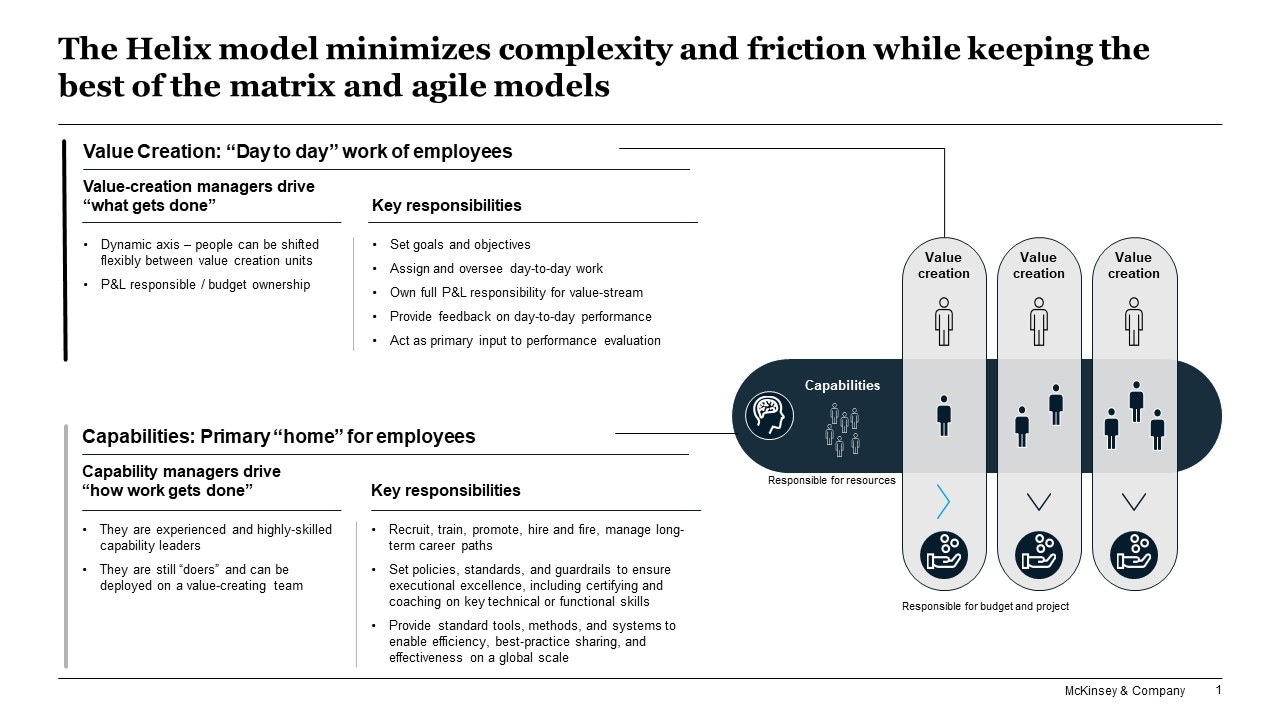As our business environment becomes more interconnected, we have accepted complexity. We replicate it through convoluted matrix structures, supported by the same management tools that have been around for decades.
These hierarchical charts with solid and dotted-line reporting relationships are complicating organizations, becoming slow and inflexible—the opposite of what’s needed nowadays. Additionally, individual employees are finding themselves reporting to multiple “bosses” making day-to-day tasks a slog. Leaders often reorganize to try and solve the pain points of “efficiency and streamlined, central steering” versus “speed and flexibility with decentral ownership,” creating new pain points.
We are convinced that there is a simple model that can replace matrix structures—designed for stability and dynamism—which will encourage small, ongoing adaptations over full reorganizations. We call it the helix organization model.
The secret to this model’s success lies in disaggregating the traditional split of management tasks into two, distinct parallel lines of accountability that are roughly equal in power and authority, but fundamentally different (see Exhibit).

People leadership tasks typically done by one manager are decoupled into two sets of tasks performed by two different managers. One emphasizes value creation, or what gets done, by setting priorities for the business – overseeing day-to-day work, creating value and helping deliver a full and satisfying customer experience. The other is attuned to capabilities, or how work gets done. They develop people and resources, set standards for working and drive functional excellence.
Neither manager is considered primary nor secondary. Instead, similar to the “double helix” structure of a DNA molecule, both sides are intertwined and play essential roles in leading teams.
When done correctly, this model creates a lot of flexibility, as the people ownership in the capability axis enables flexible shifts of people into the value creation axis. By strengthening the business leadership of the value manager, on the other hand, it also allows for more speed in the business.
Consider Tom, a composite example based on dozens of managers with whom we’ve worked. Tom is a mid-tenured R&D director in a matrix structure, and while his priorities change from time to time, his relationship with his primary boss – the head of research and development is clear, telling him, what the key priorities are and how he should perform the work. However, Tom also has a dotted line boss – the project leader for the development project he works on out of the product management organization. Tom strives to please both managers, or he must manage the consequences of prioritizing one over the other. The ambiguity that Tom feels is often reflected in his year-end review, as both bosses have a say.
Alternatively, the helix model clarifies managerial relationships. In Tom’s case, while he is still accountable to two leaders, they have equal importance and their responsibilities are clearly divided. One – the project manager – is responsible for advising the day to day work, the head of R&D, the former primary manager, would ensure that Tom uses the best R&D tools and methods and builds the capabilities he needs. But Tom’s manager would not get involved in the stage gate meetings to not interfere with the day to day job.
It is important to note that this is not a new idea, but so far unnamed. From our experience, this is an advanced model for many organizations. We see some critical requirements, e.g. a new way of managing for both lines. Value managers need to let go of the idea that they can only manage the business when they have a “solid” line to those they manage, and capability managers need to let go of interfering in day to day business decisions.
Both can be developed—a topic we address in part two and part three.
